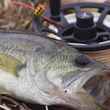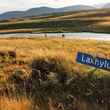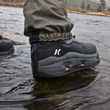We had just topped Tincup Pass headed east toward Star Valley and, eventually, the Wyoming Range to chase cutthroats, when I noticed a thin, wispy line of smoke rising from the crest of the Caribou Range to our north.
As we rounded a bend in Highway 34, full-on flames appeared high atop the mountain. A lodgepole appeared to be fully engulfed in flame—it burned furiously amid the sea of green along the slope. The night before, the wind kicked up and it rained a bit, but lightning lit up the evening sky at a steady clip.
Even after a wet winter and a dreary, rainy spring, summer’s heat is starting to get the best of the mountains, and lightning strikes can and do ignite fires that can burn for days, even weeks, if left unchecked.
And that’s the rub. Over the last century or so, our forest managers across the West have responded to the will of the populace—and the political will of those in D.C.—and done their level best to suppress wildfires, often as soon as they appear, and often with serious aggression.
The result is a West full of forests with more fuel than would normally be present—some areas haven’t burned at any significant level for more than 100 years. Not only does fire suppression leave unburned fuels lying about awaiting the next lighting strike, but it reduces quality habitat for important animals, like elk and mule deer.
A good example? The Great Burn of 1910 scorched more than 4,500 square miles of heavy timber in Montana, Idaho, southern British Columbia and eastern Washington. It killed 87 people and is the stuff of wildland firefighting legend. But this area of the Idaho Panhandle and northwest Montana hasn’t seen a fire of this significance since--the plate is set for a reprisal more than a century later.
And the elk herds of legend in the Clearwater region of Idaho? Marginal today at best--the canopy has closed in, reducing meadow habitat and migratory corridors away from dense forests where elk are more susceptible to predators. Then, in 1995, wolves were reintroduced to the area, and the elk decline became much more noticeable.
A lot of hunters will blame the decline of Clearwater elk on wolves, but when you reintroduce an apex predator atop an elk herd surviving in less-than-ideal habitat, the outcome is fairly predictable. Fewer elk. More pissed off hunters.
Couple the lack of significant wildfires (or overzealous control of naturally sparked fires) with the loss of salmon and steelhead and the nutrients they brought with them from the ocean into the Clearwater backcountry thanks to the completion of the Dworshak Dam on the Clearwater River in 1973, and it’s easy to see that the region has been in ecological turmoil for some time now.
We hear a lot about controlled burns and, sometimes when blazes don’t threaten structures or people, a hands-off approach to wildfire. But, by and large, this is the exception. Big fires still get the attention today of agency fire chiefs—it’s their job to suppress fires and keep forests intact (even if this contributes to significant forest health issues).
And, when an area that hasn’t burned for decades or longer finally ignites during a dry summer, we all share in the tragedy of watching our landscape go from lush and green to an ashy moonscape. These fires, the ones fed by years and years of fuels build-up and pushed along by climate change, are the ones we remember. They take out homes and cabins and, sometimes, entire communities.
And, just a side note: All the raking in the world can’t help, either.
So as we headed down Tincup Pass toward Star Valley and a solid cell signal, I was conflicted. On the other side of the mountain from this newly ignited fire sits one of my favorite places to camp and fish for native cutthroats. While this year’s fire season has been mild to date, more lightning strikes will ignite more fires, and, one day, my favorite place to spend days at a time in the mountains might become the next charred landscape.
But I did call the Caribou National Forest when we got off the mountain. I did tell the ranger on the phone where the fire was and how big we thought it was. He was thankful.
“Thanks for letting us know,” he said. “I’ll see if we can get dispatch on it.”
When I hopped online to check out the fire a day later, I noticed that the Tincup Fire hadn’t done much. It was listed as “active,” and it was noted that it had burned only half an acre.
We’ve been lucky this summer, at least so far. But the fires are coming. And so are the lessons we should have heeded more than a century ago.






























Comments